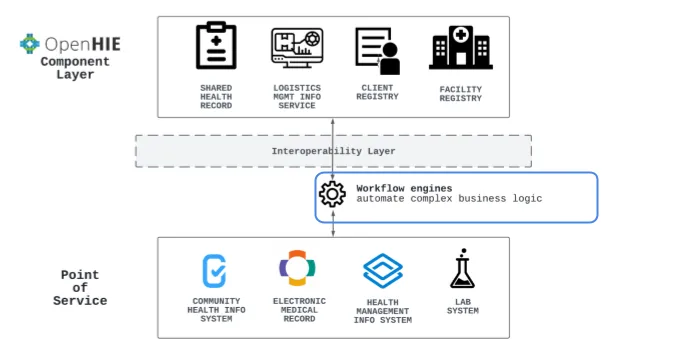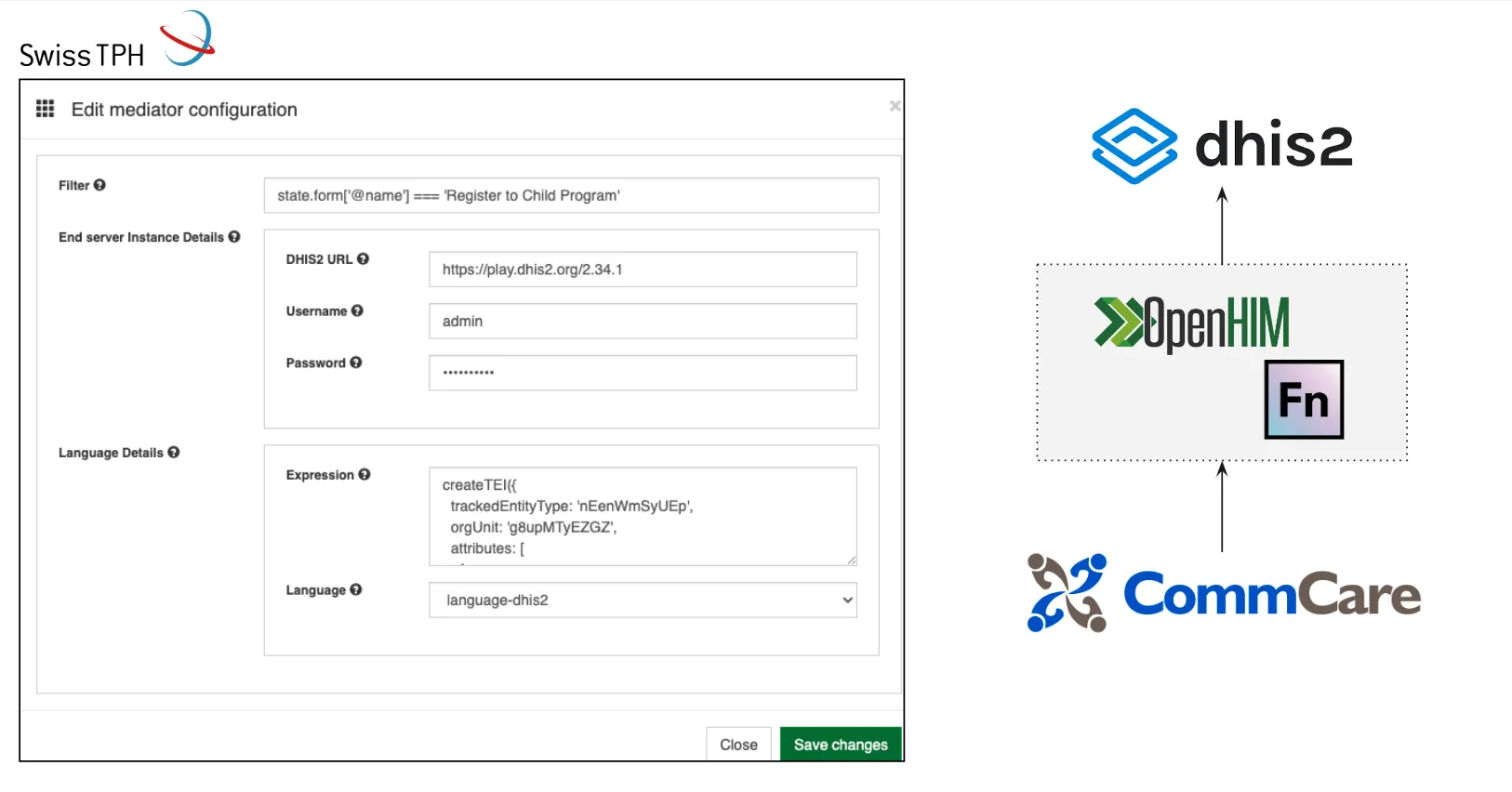Standards & OpenFn
OpenFn follows global standards for open source software and for workflow engine solutions. Read on to learn how OpenFn complies with specific standards.
Digital Public Good
OpenFn is recognised by the Ditial Public Goods Alliance as a Digital Public Good, or "DPG".
Open-source software, open data, open AI models, open standards, and open content that adhere to privacy and other applicable best practices, do no harm by design and are of high relevance for attainment of the United Nations 2030 Sustainable Development Goals (SDGs)
You can read more about the DPG standard here.
Global Good for Health
OpenFn is one of 36 software applications that have been recognised as a Digital Square Global Good for Health.
A mature digital health software global good is software that is Free and Open Source Software (FOSS), is supported by a strong community, has a clear governance structure, is funded by multiple sources, has been deployed at significant scale, is used across multiple countries, has demonstrated effectiveness, is designed to be interoperable, and is an emergent standard application.
You can read more about Global Goods for Health here.
OpenHIE Standard Architecture
OpenFn is considered a OpenHIE reference technology and is compliant with the OpenHIE standard architecture for digital health implementations.
This section assumes you are familiar with the OpenHIE specification–a reference framework that makes sharing health data across information systems possible through a Health Information Exchange (“HIE”). To learn more, check out OpenHIE docs and community.
OpenFn and OpenHIE
The OpenFn platform v2 (OpenFn/lightning) is an OpenHIE-compliant workflow engine used to (1) automate complex business processes that cut across digital systems (including OpenHIE components and point of care systems), and to (2) handle data mapping and transformation.
If your organization is implementing the OpenHIE standard architecture, then OpenFn provides a workflow engine that interfaces with your interoperability later component (“IOL”). OpenFn can be implemented to automate:
- Workflows between point of service systems;
- Workflows between across core HIE components;
- Data transformation steps required to prepare data before routing it to other HIE components via the IOL. (Note that OpenFn workflows serve as a web-UI-accessible and manageable alternative to OpenHIM “mediators”.)
OpenFn supports the functional requirements of the OpenHIE IOL, therefore some organizations also use OpenFn as their central interoperability layer. That said, please note that OpenFn cannot yet be used as a fully OpenHIE-compliant _interoperability layer _because it does not leverage the IHE ATNA profile (see requirement IOL-WF1).

For an overview of OpenFn Lightning and how it fits into OpenHIE, see our introduction for the OpenHIE showcase or read on for more context.
More on how OpenFn supports the OpenHIE spec
The Interoperability layer (IOL):
- Sits between the OpenHIE components and point-of-care systems
- Serves as a single point of entry and secure gateway to the OpenHIE
- Complies with requirements around transaction routing and auditing
OpenFn Lightning satisfies the functional requirements of the IOL, but is not fully OpenHIE-compliant since it does not yet leverage the IHE ATNA profile
The workflow engine:
- Provides out-of-box interfaces to connect to point of care systems
- Handles complex data mapping and transformation to reformat data for receipt by a destination system (e.g., map data from point of care system to the data model of a OpenHIE component, and/or map non-FHIR data to FHIR profiles)
- Routes data to the interoperability layer
- Can keep track of the long running state of a patient's care and perform actions based on this context (such as sending alerts) to improve patient care.
OpenFn Lightning is an OpenHIE-compliant workflow engine
Case study: OpenFn as an OpenHIM Mediator
In Nigeria, as part of the ALMANACH project, SwissTPH used OpenFn to automate data mapping and exchange between CommCare and DHIS2 for disease surveillance. The workflow ran on OpenFn’s cloud for several years and in preparation for handover and scaling-up, the team at SwissTPH then prepared a deep integration with OpenHIM for local deployment.
SwissTPH took their existing OpenFn workflow and built it into their OpenHIM instance as a “mediator”, ensuring all data is routed via this IOL while still leveraging OpenFn’s out-of-box DHIS2 adaptor and reusable workflow templates to quickly develop automation that reformats data received from CommCare and maps it to the DHIS2 data model.

GovStack
OpenFn is compliant with GovStack's standard specification for workflow engines.
Pricinciples for Digital Development
OpenFn was designed for the social sector and has been actively prioritizing the Principles of Digital Development since its inception.
OpenFn solutions are:
- interoperable (connect any application);
- reusable (utilize existing OpenFn configurations as templates, or easily share, copy, and modify your own configurations; see docs.openfn.org/library);
- sustainable (flexible implementation options with no lock-in);
- scalable (OpenFn leverages enterprise-grade tech to handle high data volumes and provides a range of deployment options to ensure total solution ownership on any server);
- promote open standards and open access (through our open-source software, documentation, and features to help users implement open standards in their information exchange solutions), and
- address privacy & security.
FHIR for health data exchange
FHIR (pronounced "fire" 🔥) is a standard for health care data exchange, published by HL7®.
OpenFn is used by health organizations to connect multiple FHIR- and non-FHIR compliant systems in a secure, stable, and scalable manner. OpenFn can facilitate 2 categories of FHIR workflows:
1. Non-FHIR to FHIR Data Exchange
OpenFn users can configure workflows to convert non-FHIR data to FHIR-compliant formats, and then route to FHIR systems.
For example, get data from CommCare mobile app, convert to FHIR, and send to
national health system's FHIR store.

2. FHIR to FHIR Data Exchange
OpenFn users can also configure Workflows to automate the exchange and routing of already FHIR-compliant data to other FHIR-compliant systems.
For example, get data from OpenMRS's FHIR API, and forward to the national health system's FHIR store (no data transformation needed).

FHIR Adaptors
OpenFn adaptors fast-track integration setup with target applications (including FHIR endpoints!). The core team is currently working on a suite of FHIR-specific adaptors to enable interoperability with FHIR systems.
The fhir-4 adaptor makes it easy to access and modify data held on any FHIR r4 compliant server. It also provides full code-assist to developers while creating specific resource definitions, simplifying data-entry and mapping logic.
We also provide a generic fhir adaptor that's compatible with all FHIR versions.
The fhir-4 adaptor is new to OpenFn as of March 2025. It introduces richer
levels of support from the generic fhiradaptor. Support for
other FHIR versions is coming soon
See the Adaptors Wiki to learn how to build your own FHIR adpator specific to your target FHIR Implementation Guide
Other Data Standards
OpenFn Workflows can automate data transformation, cleaning, and formatting rules to ensure compliance with your organization's specific standards.
Ask on the community to explore how OpenFn can be leverage to help automate application and enforcement of other data standards.